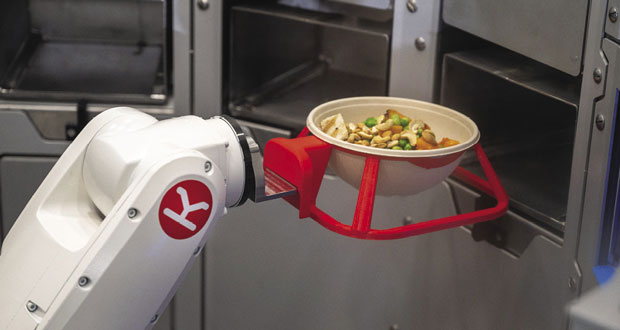DEPLOYMENT OF SEMBLR
The logical place for deployment was Ocado’s own head office staff restaurant, run by Angel Hill Food Co, the specialist corporate catering division of Atalian Servest. The aim was to give the customer an unparalleled choice in what goes into their meals. With 2,700 different combinations of the dishes on offer, staff could specify down to the gram what hot and cold items, proteins, sauces and fresh toppings they wanted, something that is simply not possible in traditional restaurants and commercial catering.
Getting the project off the ground says Atalian Servest’s Chef Director Chris Ince, required a huge team effort between caterers and engineers to complete a ‘fit for purpose’ offer.
“Let’s face it we had some chefs and some engineers where there hasn’t been a lot of interaction before now so in the first few weeks we were dancing around each other, but it’s now very smooth and easy and the key point is there is a lot of trust there.
“Our job was to ensure we reduced the possibility of customer error, for instance if you’re customising your own bowl you don’t want a range of conflicting ingredients, it all has to run on a theme and be coherent, and so there was an extensive testing process with the team to ensure the ingredients we wanted to put in would hang together.
“For us it’s fantastically exciting and a radically different service from what came before. What the machine does is extraordinary and where it is breaking new ground is that the range of products and the ability to customise your lunch is almost limitless. It’s sparked new lines of thinking, new thought processes, it’s been very stimulating, it’s been motivating and we’re absolutely delighted.”
Says Wragg: “Chris and his team have been fantastic at working with us on what kind of menu we should have, what works with the type of proposition we have, and using what Atalian Servest knows about staff eating habits and how we can do it at a price that works. Their expertise on everything from compliance issues to health and safety took us from the concept stage right through to onsite, serving meals every day.”
With this kind of complex installation, Wragg reveals in the early days a large engineering team was deployed to ‘super-service’ the robot. The onsite team has been reduced in recent months to one full time support person and two interns, which he admits: “is overkill but this is our prototype and we want to support Atalian Servest. In the long term a machine like this would probably be working with one member of staff back of house and portering and one member of staff running the customer interface.”
For his part Ince explains that from the back of house perspective serving food via a robot requires a different kind of approach. For instance, instead of humans providing direct customer service they’re instead loading ingredients into a robot, but he reveals: “the process has been successfully weaved into the production plan for the kitchen, just with a few different agreed parameters and cooking methods.”
He also points out that because the Semblr produces personalised hot and cold meals, it delivers complete accuracy of portion size, and given concerns about issues such as food allergies etc, affords total traceability of ingredients.
“One of the benefits is at the point of service everything is segregated so there is no danger of cross contamination whereas in a traditional service there is potential for error.”





